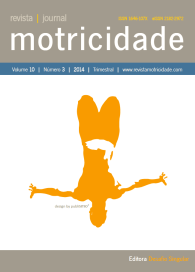Anthropometric parameters, but not aerobic fitness, associates with vascular reactivity of blood pressure in men
DOI:
https://doi.org/10.6063/motricidade.2708Abstract
The aim of this study was to verify the association between anthropometric parameters and aerobic fitness with vascular reactivity of blood pressure (VRBP) at healthy male subjects. It was assessed in forty apparently healthy male (27.3 ± 6.3 years; 77.2 ± 11.5 kg; 175.7 ± 6.9 cm) the body mass index (BMI), waist circumference (WC), waist-rip ratio (WRR), body fat (%BF), maximum oxygen uptake (VO2max) and a VR test of BP (Cold Pressor Test - CPT) with immersion of hand in the water (4º Celsius during 1 min). There was no association between aerobic fitness (VO2max below or above of mean and relationship test) and VRBP (p> 0.05). Anthropometric indicators as BMI (r= 0.31 / 0.54), WC (r= 0.30 / 0.49), WRR (r= 0.30 / 0.36) and %BF (r= 0.31 / 0.35) showed positive relationships with VRBP (p< 0.05). However, only WC during the CPT (β= 0.30 / 0.43) and BMI after the CPT (β= 0.54 / 0.81) were predictors of VRBP (p≤ 0.05). We conclude that anthropometric indicators showed independents relationships with VRBP. Nevertheless, only the WC (during) and BMI (after) were significant predictors of VRBP, suggesting that body adiposity, independent of aerobic fitness, have an important role as a cardiovascular risk factor.Downloads
Published
Issue
Section
License
The authors of submitted manuscripts must transfer the full copyright to Journal Motricidade / Sílabas Didáticas Editions. Granting copyright permission allows the publication and dissemination of the article in printed or electronic formats, and copyrights start at the moment the manuscript is accepted for publication. It also allows Journal Motricidade to use and commercialise the article in terms of licensing, lending or selling its content to indexation/abstracts databases and other entities.
According to the terms of the Creative Commons licence, authors may reproduce a reasonable number of copies for personal or professional purposes, but without any economic gain. SHERPA/RoMEO allows authors to post a final digital copy (post-printing version) of the article on their websites or on their institutions' scientific repository.


